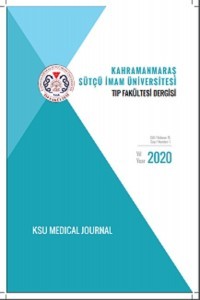Elazığ Eğitim Araştırma Hastanesi Yenidoğan İşitme Taraması Sonuçları
Yenidoğan, İşitme Taraması, İşitme Kaybı
The Results of Newborn Hearing Screening of Elazığ Training and Research Hospital
Newborn, Hearing Screening, Hearing Loss,
___
- 1. Thompson DC, McPhillips H, Davis RL, Lieu TL, Homer CJ, Helfand M. Universal newborn hearing screening: Summary of evidence. JAMA 2001; 286: 2000-10.
- 2. Oudesluys-Murphy AM, V an Straaten HL, Bholasingh R, V an Zanten GA. Neonatal hearing screening. Eur J Pediatr 1996; 155: 429-35.
- 3. Kemp DT, Ryan S, Bray P. A guide to the effective use of otoacoustic emissions. Ear Hear 1990; 11: 93-105.
- 4. Turkewitz G, Kenny PA. The role of developmental limitations of sensory input on sensory/perceptual organization. J Dev Behav Pediatr. 1985; 6: 302-6.
- 5. Committee on İnfant Hearing 1994 Position Statement. American Academy of Pediatrics Joint Committee on İnfant Hearing. Pediatrics 1995; 95: 152-6.
- 6. Mazurek B, Winter E, Fuchs J, Haupt H, Gross J. Susceptibility of the hair cells of the newborn rat cochlea to hypoxia and ischemia. Hear Res. 2003; 182: 2-8.
- 7. Newton V. Adverse perinatal conditions and the inner ear. Semin Neonatol. 2001; 6: 543 - 51.
- 8. Merchant SN, Gopen Q. A human temporal bone study of acute bacterial meningogenic labyrinthitis. Am J Otol. 1996; 17: 375 - 85.
- 9. Martin WH, Schwegler JW, Gleeson AL, et al. New techniques of hearing assessment. Otolaryngol Clin North Am 1994; 27: 487 - 510.
- 10. Morgan DE, Canalis RF. Auditory screening of infants. Otolaryngol Clin North Am 1991: 24: 277 - 84.
- 11. Kemp DT, Ryan S. The use of transient evoked otoacoustic emissions in neonatal hearing screening programs. Semin Hear 1993; 14: 30 - 45.
- 12. Karaca ÇT, Toros SZ , Naiboğlu B, Verim A, Çelebi Ş. Yenidoğan İşitme Taraması Sonuçlarımız. Van Tıp Dergisi: 2014; 21: 67-71.
- 13. Yılmaz B, Küçükbayrak B. Yenidoğan işitme tarama sonuçlarımız. Abant Med J 2013; 2: 204-7.
- 14. Arıcıgil M, Ulutaş AR, Yücel A, Arbağ H. Yenidoğan İşitme Tarama Sonuçlarımız. Selçuk Tıp Derg 2015; 31: 121-3.
- 15. American Academy of Pediatrics. Task Force on Newborn and Infant Hearing. Newborn and infant hearing loss: detection and intervention. Pediatrics 1999; 103: 527- 30.
- ISSN: 1303-6610
- Yayın Aralığı: Yılda 3 Sayı
- Başlangıç: 2004
- Yayıncı: Kahramanmaraş Sütçü İmam Üniversitesi
MEHMET BOŞNAK, AKİF HAKAN KURT, SELMA YAMAN
Klinik Araştırmalar: Türkiye’deki Güncel Mevzuatın Bir Özeti
Gebelerde 50 gr Oral Glukoz Tolerans Test Sonuçları ile Vücut Kitle İndeksinin Karşılaştırılması
Uğurkan ERKAYIRAN, Selim KONCAGÜL, Zahide KÜÇÜK
30 mm’den Küçük Renal Pelvis Taşlarının Üreteroskopik Tedavisi
Tayfun ŞAHİNKANAT, Hasan Çetin EKERBİÇER
Tayfun ŞAHİNKANAT, Faruk KÜÇÜKDURMAZ, Erkan EFE, Eyüp Koluş, Hasan Çetin EKERBİÇER, Muharrem Bitiren
Kahramanmaraş Atmosferinde Bulunan Allerjen Fungusların Belirlenmesi
Ekrem KİREÇCİ, Gökhan ALAGÖZ, Sibel DAĞLI
İlk kez tariflenen bir konka bülloza rinoliti olgusu eşliğinde rinolitlerin tartışılması
Murat Baykara, Cahit Polat, Halit Vicdan, Öner Sakallıoğlu
Elazığ Eğitim Araştırma Hastanesi Yenidoğan İşitme Taraması Sonuçları
Nihat SUSAMAN, Öner SAKALLIOĞLU, Yavuz Sultan Selim YILDIRIM, Sertaç DÜZER, Abdulvahab AKYİĞİT, Cahit POLAT
Arteriyel Sertlik Parametrelerinin Ultrasonografi ile Ölçümünde Ölçücülerin Uyumu
